Recife, June 1922. Shortly after his triumphant landing, a reporter asks naval lieutenant aviator Artur de Sacadura Freire Cabral (1881–1924): “What were you thinking when you decided to attempt the crossing?” “I wasn’t,” he replies. “If I had I wouldn’t have done it.” With his arrival in Recife on the fifth day of that month, the Portuguese pilot and his navigator, rear admiral Carlos Viegas Gago Coutinho (1869–1959), had successfully completed the world’s first aerial crossing of the South Atlantic, from Portugal to Brazil, after covering 8,383 kilometers in a 62h26min flight from Lisbon, from where they had departed on March 30 (see map). Halfway through the longest leg of the journey, they had been faced with the risk of crashing and dying at sea when they realized the first of the three floatplanes they used for the crossing was burning more fuel than anticipated.
“It was a tense flight, with the two aviators using rudimentary navigation instruments under wind and rain in the open cockpit of their single-engine biplane [an airplane with two main wings stacked one above the other],” says Henrique Lins de Barros, a physicist at the Brazilian Center for Physics Research (CBPF) in Rio de Janeiro, and a scholar of the life and work of Alberto Santos-Dumont (1872–1932) (see Pesquisa FAPESP issue nº 138), who described the exchange between the Portuguese aviator and the reporter. The first South Atlantic crossing also marked the beginning of air navigation: Coutinho had invented two of the world’s first navigation instruments—an aeronautical sextant and a path corrector—for use on the voyage.
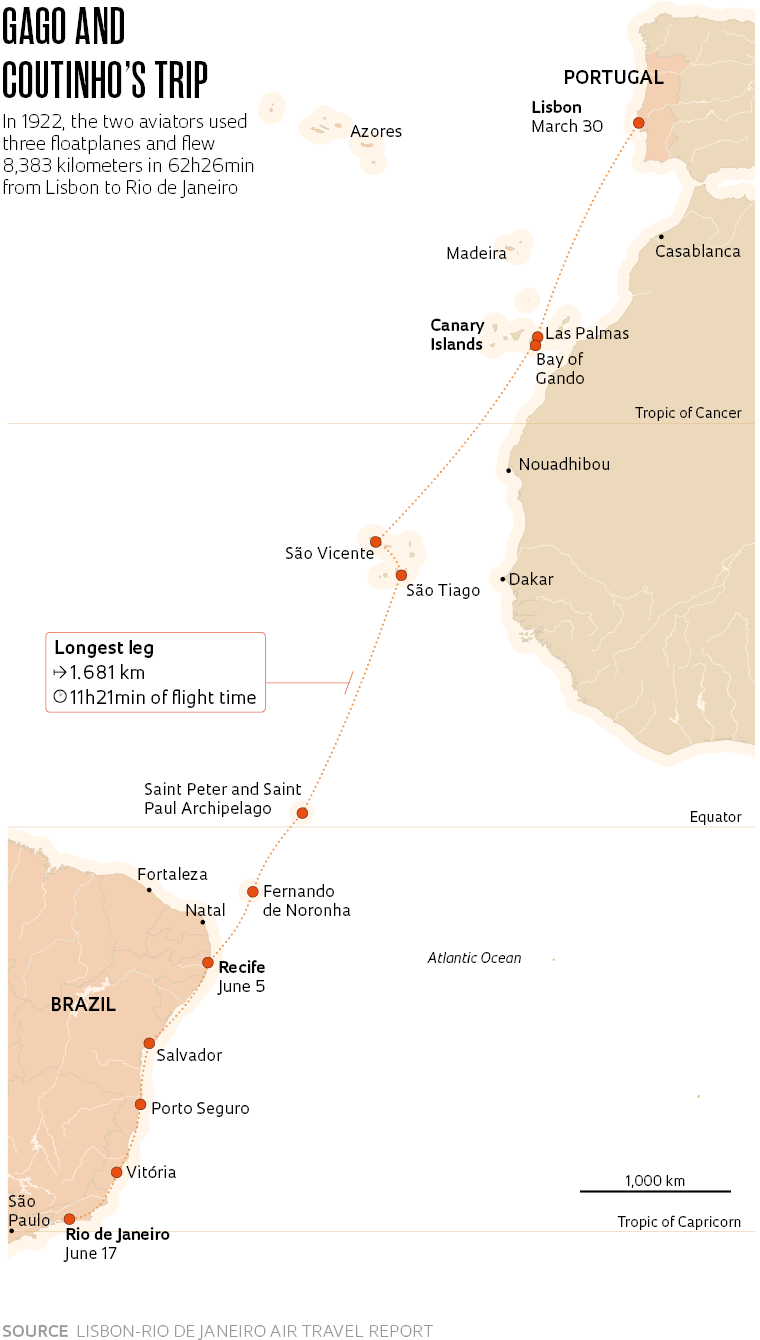
The aeronautical sextant was adapted from its naval equivalent to measure the altitude and latitude of celestial bodies (the Sun or stars) without reference to an observable horizon. Because the airplane was constantly in motion, making measurements difficult, Coutinho created an artificial horizon using a level with an air bubble, like the ones masons use to align bricks. Coutinho described his artificial horizon system in the 1919 edition of the journal Anais do Clube Militar Naval, and tested it with Sacadura Cabral in 1921 on a 972-kilometer (km) flight from Lisbon to Madeira Island. In addition to their position, the aviators needed to determine their flight path adjusted for the effect of side winds. They did this using smoke bombs dropped onto the water surface, combined with the use of the path corrector. “The two devices allowed the aviators to fly long distances without terrestrial reference points,” highlights Barros.
Cabral recounted how the idea to attempt the crossing occurred to him after a visit from Epitácio Pessoa (1865–1942)—then President of Brazil—to Lisbon in June 1919. One month prior, the Curtiss NC-4—a flying boat measuring 20.8 meters (m) in length and 38.4 m in wingspan, piloted by rear admiral Albert Cushing Read (1887–1967)—had become the first airplane to complete a flight across the Atlantic Ocean, covering a distance of 6,000 km between New York and Plymouth, England in 23 days, with 6 stops along the way; a fleet of 68 vessels stationed 50 to 75 miles (92 to 140 km) apart helped the crew to get their bearings and provided assistance in any water landings; of the three aircraft that attempted the crossing, each with its own crew, only one made it across. Cabral was part of the group that greeted Read during his stop in Lisbon.
Soon after, on June 14, captain John Alcock (1892–1919) and lieutenant Arthur Whitten Brown (1886–1948), both British, completed the world’s first nonstop transatlantic flight on the Vickers Vimy, a twin-engine biplane measuring 13.28 m in length and 20.75 m in wingspan; guided only by a compass and a sextant, they covered a distance of 3,186 km from St. John’s, Newfoundland, to Chifden, Ireland, in 12 hours.
In these two crossings, “celestial navigation had not been used as the longest flight leg—400 miles [780 km] between stops—could be navigated using estimated bearings,” wrote Brazilian aviator Manuel Cambeses Júnior (1942–2019) in his book A primeira travessia aérea do Atlântico Sul (The first South Atlantic crossing; Instituto Histórico-Cultural da Aeronáutica, 2008). He goes on to note that: “In those early days, aviators were unfamiliar with the trade winds that could divert their planes from their course, and aircraft were still very dangerous. In 1914, when World War I broke out, France prohibited the use of airplanes on the argument that they killed more pilots than enemy troops.”

Historical Archives of the Portuguese Air Force
Cabral and Coutinho departing from Lisbon on the Lusitânia, with the Belém Tower in the backgroundHistorical Archives of the Portuguese Air ForceIn his account of the South Atlantic crossing, Cabral wrote that he hoped to pay tribute to Brazil, which was celebrating the 100th anniversary of its independence from Portugal, and strengthen bonds of friendship between the two nations. He had planned to recruit support from the two countries’ navies, but reported only receiving assistance from the Portuguese government.
“In planning the crossing, when they realized they would need to land on the sea as the distance was too long for a nonstop flight, Cabral and Coutinho concluded they would need to use a floatplane, which was less powerful and slower than a Vickers,” notes Marcello Augusto Faraco de Medeiros, a mechanical engineer at the University of São Paulo at São Carlos School of Engineering (EESC-USP), who has done research about the crossing. “One of the problems they encountered is that floatplanes weren’t optimally designed for long-distance flights, one reason being that they created more drag than other types of aircraft.”
To better understand the effort behind the Atlantic crossing, Jacques Waldmann, a mechanical engineer and a sailor by hobby, at the Brazilian Air Force Institute of Technology (ITA), decided to read a book about navigation that his father had given him, Concise spherical trigonometry, by Jacques Redway Hammond (Houghton Mifflin, Boston, 1943). “They applied knowledge about celestial navigation and spherical trigonometry—the use of sextants, chronometers, compasses, nautical and aerial almanacs, and star charts—that is no longer taught in schools but could come in handy in the event that the GPS systems we have become so reliant on fail.” Asked whether he would have joined the two Portuguese aviators if he could, he replied: “In my early 20s I might have welcomed the adventure, but at my current age of 60, I’d probably be more cautious.” Medeiros and Barros are more direct: they absolutely would not. “It was a high-risk venture,” argues Medeiros.

Historical Archives of the Portuguese Air Force
Cabral (left) and Coutinho dressed in formal attire, after the crossingHistorical Archives of the Portuguese Air ForceCabral and Coutinho outfitted three British-made Fairey III biplanes purchased by the Portuguese Navy, with a length of 11.2 m and a wingspan of 19.1 m. Aboard the first, the Lusitânia, they set out from Lisbon at 7 a.m. on March 30. They made stops in the Canary Islands and in Cape Verde, where they prepared for the longest and most difficult leg of the journey: a 1,682 km transoceanic flight to the Saint Peter and Saint Paul Archipelago, a collection of rocky islands around 986 km off Brazil’s coast. “The risk of them missing this tiny speck of an island in the middle of the ocean, was huge,” says Medeiros. “They had to check their flight path constantly, and correct it whenever the wind direction changed.”
In their account of the crossing, the aviators reported flying at an altitude of 200 to 300 m, measured using a device called an aneroid. Cabral would swoop down to 30 m when Coutinho needed to drop smoke bombs—made of mixture of calcium phosphide that would ignite on touching the sea surface. The smoke created by the reaction provided a reference point by which they could correct their flightpath using a path corrector. The pitching of the plane caused by the wind also made measurements with the sextant difficult.
In addition to uncertainty about their flightpath, the two aviators realized with alarm that the plane was burning more fuel than expected. Later, in his account of the crossing, Cabral recognized this to be the most bitter part of the trip: “For nine-and-a-half hours I was never sure we had enough fuel to complete the flight.”
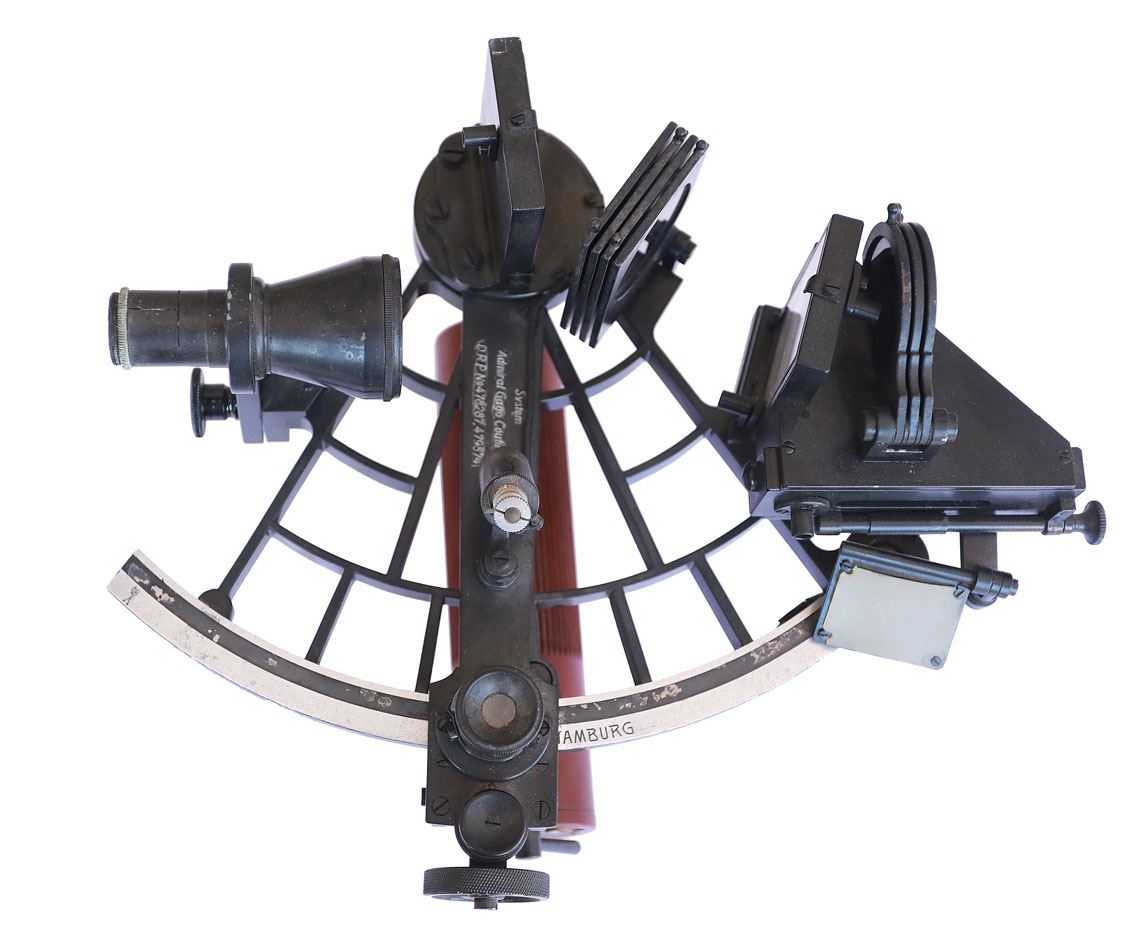
Breno Fazoli de Almeida Diniz / Rio de Janeiro Aerospace Museum
A sextant modeled after the one developed by Gago Coutinho (right), at the Rio de Janeiro Aerospace MuseumBreno Fazoli de Almeida Diniz / Rio de Janeiro Aerospace MuseumCoutinho’s fears proved to be somewhat warranted. At 5 p.m., after an 11-hour nonstop flight, they arrived at the archipelago with only three liters of fuel left, and soon spotted the Portuguese navy ship Republica, waiting for them as planned. As they alighted on the heavy seas, one of the floats was ruptured and the plane soon began to heel; they had just enough time to salvage their navigation instruments and climb aboard the ship before the Lusitânia sank.
Cabral and Coutinho were carried aboard the República to Fernando de Noronha, where they waited as the Portuguese government sent another Fairey III seaplane, the Patria, to complete the journey. They fitted this plane with an extra fuel tank and resumed the crossing on May 11. Intent on completing the whole distance, they decided to fly back to the Saint Peter and Saint Paul Archipelago, where their journey had been interrupted, but an engine problem forced them to ditch in the ocean. The two aviators, unable to restart the engine, spent nine hours drifting on the floatplane until they were saved by a British cargo ship.
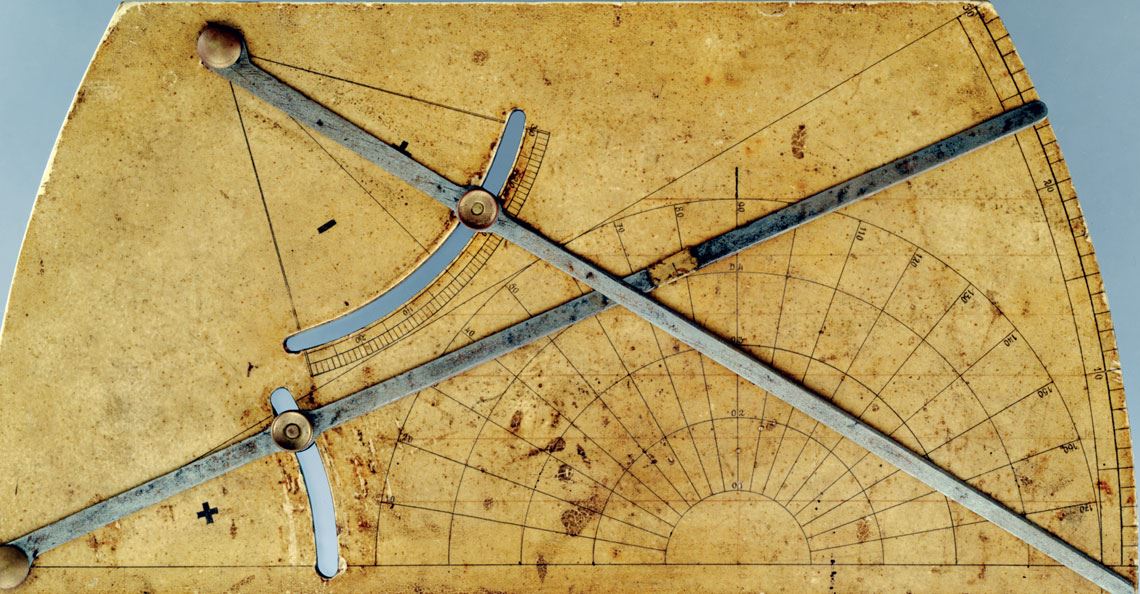
Navy Museum, Portugal
A flightpath corrector used to account for the effects of sidewinds on an airplane’s flight pathNavy Museum, PortugalThe República was called and took them aboard a second time, but only managed to salvage the aircraft engine. A third floatplane, the Santa Cruz, arrived in Fernando de Noronha on June 2 aboard another Portuguese warship. With the Santa Cruz, they flew without incident to Recife and then down the coast of Brazil, passing through Salvador and then Vitória, in Espírito Santo, before completing their journey in Rio de Janeiro on June 17.
In Rio, as in other places where they had stopped, they were greeted to a heroes’ welcome. “The city is entirely adorned. There is not a building in the city center without a banner streaming down its facade,” the Santos newspaper A Tribuna reported on June 18, 1922. As the two aviators paraded through the city, “the shouts from the crowd blended with the horns of dozens of yachts, steamboats, and warships, their crews leaning excitedly over the side.”
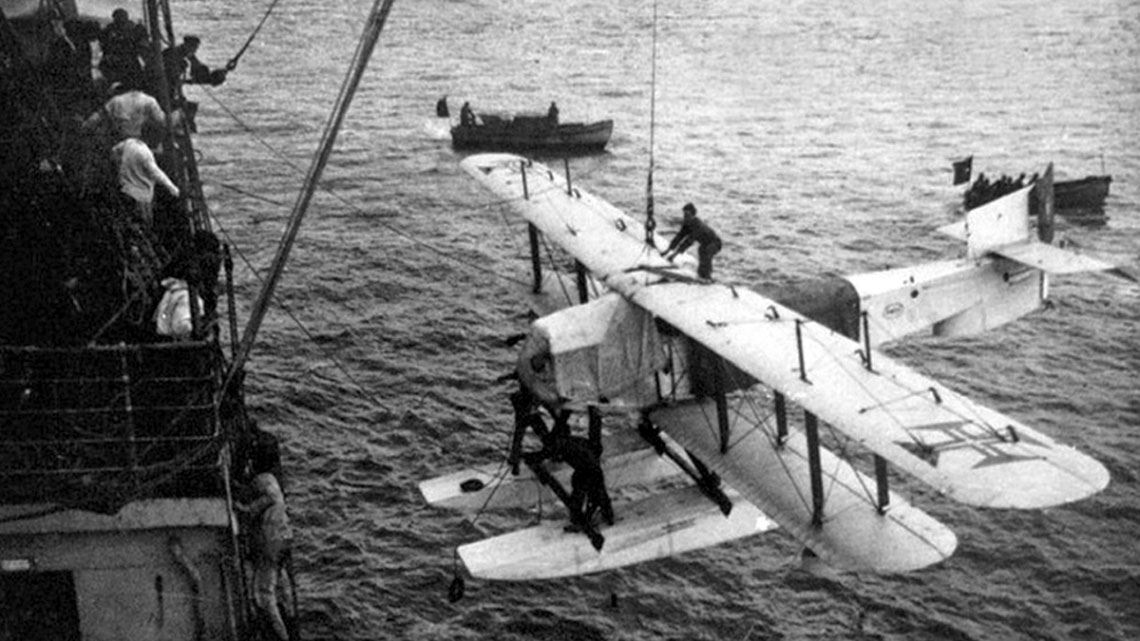
3 Historical Archives of the Portuguese Air Force
The third floatplane, Santa Cruz, being lowered to the sea near Fernando de Noronha, to complete the two aviators’ journey3 Historical Archives of the Portuguese Air ForceOther notable flights
In Rio, among the government officials and representatives from the Portuguese community who attended dinners with the two aviators was Theresa di Marzo Roesler (1903–1986), Brazil’s first female aviator, who had received her license in April that year. In 1926 she married her instructor, the German pilot Fritz Roesler (–1971), who forbade her to continue flying, saying that one aviator in the family was enough. Cabral had died two years prior, in 1924, in an airplane crash on a return flight from Amsterdam to Lisbon. Coutinho lived to the ripe age of 90.
In June 1926, the Brazilian aviator João Ribeiro de Barros (1900–1947) traveled to Italy with his friend Vasco Ciquini (1900–1930), a mechanic, to purchase a floatplane for an attempted flight across the Atlantic. The manufacturer, Savoia-Marchetti, refused to sell him a new plane, fearing that an unsuccessful crossing could damage its image. After nearly sinking during testing, the used plane he was able to purchase—a twin engine, wooden-framed flying boat, measuring 16 m long and 24 m in wingspan—was overhauled and named Jahú, after Barros’s hometown. Barros and Ciquini, accompanied by João Negrão (1901–1978) as copilot and Newton Braga (1882–1959) as navigator, set out from Genoa, a seaport in northern Italy, on October 17, 1926. After several unplanned stopovers to repair the engine and replace the fuel, which was found to be contaminated, they arrived in Natal, northeastern Brazil, on May 14, 1927.
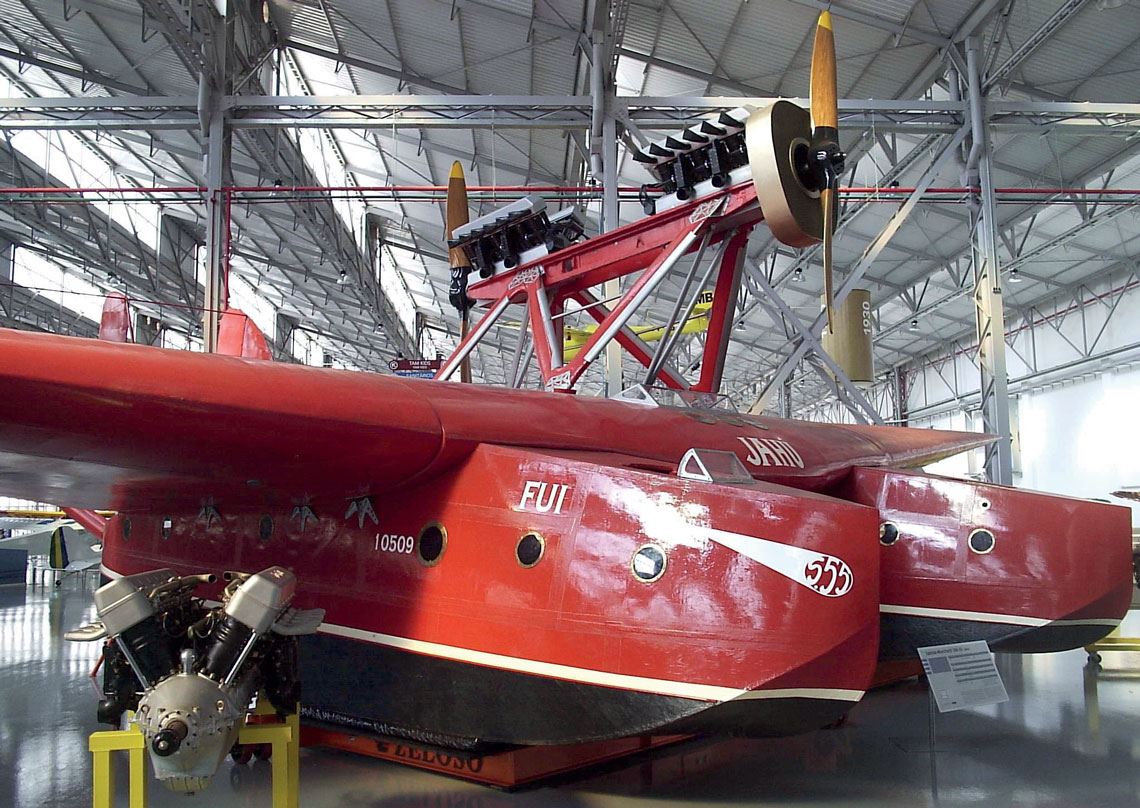
Marco Aurélio Esparza / Wikimedia
The Jahu, the flying boat the four Brazilians used to cross the Atlantic in 1927, at the TAM MuseumMarco Aurélio Esparza / WikimediaOn May 20, 1927, the American Charles Lindbergh (1902–1974) famously departed from New York on The Spirit of Saint Louis, landing in Paris the next day after a 33h31min flight. Also that year, an improved version of Coutinho’s sextant, made by German manufacturer Plath with permission from the Portuguese Navy, was tested aboard an airplane named Argos on a flight between Lisbon and Rio de Janeiro. In Brazil, 1927 saw the creation of one of the country’s first airlines, Viação Aérea Rio-Grandense (Varig), which would later become defunct in 2006.
In the 1950s, jet planes replaced propeller-driven aircraft, increasing flight speeds around tenfold. Today, an Airbus A340-600, with its four turbines, 75 m in length and 68 m in wingspan, carrying 380 passengers, can complete a nonstop flight from Recife to Lisbon in 7 hours and 15 minutes.
Republish

